11 - Laboratory Findings in Osteoarthritis
Authors: Moskowitz, Roland W.; Altman, Roy D.; Hochberg, Marc C.; Buckwalter, Joseph A.; GoldberG, Victor M.
Title: Osteoarthritis: Diagnosis and Medical/Surgical Management, 4th Edition
Copyright 2007 Lippincott Williams & Wilkins
> Table of Contents > II - General Aspects of Diagnosis > 8 - Radiologic Diagnosis
function show_scrollbar() {}
8
Radiologic Diagnosis
Garry Gold
Vijay Chandnani
Donald Resnick
The term osteoarthritis (OA), previously called degenerative joint disease, is applied to a variety of distinct processes affecting joints in extraspinal and spinal locations. There are basic differences in the anatomy of the various types of joints at these sites, and they change in unique fashions. Each type of articular degeneration is associated with characteristic clinical, pathologic, and radiologic features. This chapter discusses the radiologic manifestations of OA at extraspinal joints as well as in the various types of spinal articulations. Methods of quantitation of radiologic changes are also discussed.
Osteoarthritis of Extraspinal Locations
General Considerations
OA, the most frequent articular affliction, was not regarded as a distinct entity until the early twentieth century, when it was clearly differentiated from rheumatoid arthritis.1,2 OA is the best general phrase to describe degenerative alterations in any type of joint. These alterations may appear in fibrous, cartilaginous, or synovial articulations. The pathologic and radiographic appearances vary from one location to another, but at any site, the abnormalities appear to be related to degeneration of specific articular structures. The terms osteoarthrosis and OA are reserved for OA of synovial joints. Although inflammatory changes are not pronounced in most of these joints, OA is the term used in this chapter because this designation is widely accepted in the United States. Furthermore, in those joints in which significant synovial inflammatory abnormalities do accompany OA, such as in the interphalangeal articulations of middle-aged and elderly women, OA is the more accurate description of the disorder.
Primary and Secondary Osteoarthritis
OA has traditionally been classified into primary (idiopathic) and secondary types. Primary OA has been regarded as a process in which articular degeneration occurs in the absence of any obvious underlying abnormality, whereas secondary OA has been regarded as articular degeneration that is produced by alterations from a preexisting condition. This classification is misleading, because careful evaluation of many examples of primary OA will reveal some mechanical deviation in the involved articulation that has led to secondary degeneration of the joint. Examples include infantile and childhood disorders such as congenital dysplasia and a slipped capital femoral epiphysis; when mild, these are easily overlooked, yet later they can lead to OA in the hip. Thus, it appears likely that primary OA does not truly exist, and the use of such a designation seems only to underscore current diagnostic limitations.
Articular degeneration may result from either an abnormal concentration of force across an articulation with normal articular cartilage matrix or a normal concentration of force across an abnormal joint.3 Eventually, abnormalities of force and articular structure appear together (Table 8-1). This classification emphasizes that there are many potential causes of secondary OA and that these causes may lead to articular degeneration by increasing the amount of stress on cartilaginous and osseous structures or by directly affecting the cartilage or subchondral bone itself. These considerations have relevance to radiologic interpretation of degenerative changes in joints.
Radiographic-Pathologic Correlation
Degenerative changes are found not only in the stressed (pressure) areas of a joint but also in the nonstressed (nonpressure) segments.4 Therefore, either excessive or
P.148
diminished pressure appears to be deleterious to cartilage. Normally, cartilage derives its nutrition from intermittent intrusion and extrusion of synovial fluid during alternating periods of pressure and rest as well as from vessels in the subchondral bone, which allow material to pass into the basal layer of cartilage.5,6,7,8 Both sources of nutrition become defective in the presence of excessive or diminished stress, leading to degenerative changes.
TABLE 8-1 CLASSIFICATION OF OA | |||||||||||||||||||||||||||||||||
|---|---|---|---|---|---|---|---|---|---|---|---|---|---|---|---|---|---|---|---|---|---|---|---|---|---|---|---|---|---|---|---|---|---|
|
In the stressed segment, pathologically evident thinning and denudation of the cartilaginous surface and vascular invasion, in addition to infarction and necrosis of the subchondral trabeculae, account for joint space loss, bone sclerosis, and cyst formation that are apparent on the radiographs (Table 8-2). In the nonstressed segment, pathologically evident hypervascularity of marrow and cartilage leads to radiographically detectable osteophytosis.4
Cartilage in degenerating joints at first appears discolored, thinned, and roughened; later, crevices, ulcerations, and larger areas of erosion become evident.9,10,11 This progressive cartilage loss accounts for one of the fundamental radiographic signs of OA, loss of joint space. This diminution is characteristically located mainly in the area that has been subjected to the greatest pressure, such as the superolateral aspect of an osteoarthritic hip and the medial femorotibial space of an osteoarthritic knee. This focal cartilaginous destruction and resulting loss of the interosseous space allow differentiation from processes such as rheumatoid arthritis that lead to diffuse chondral alterations. Certain sites of involvement are exceptions to this rule; in OA of the interphalangeal or metacarpophalangeal joints of the hands as well as of the sacroiliac joint, diffuse joint space involvement may be noted.
After cartilage loss, bone eburnation becomes evident in the closely applied osseous surfaces, apparently related to deposition of new bone on preexisting trabeculae and to trabecular compression and fracture with callus formation.12,13,14,15,16,17,18 In general, radiographic evidence of joint space loss is present before eburnation becomes apparent. After progressive loss of joint space, sclerosis becomes more apparent, extending vertically into deeper regions of the subchondral bone and horizontally into adjacent osseous segments. The radiodense area may initially appear uniform, but radiolucent areas of varying size eventually appear, reflecting subchondral cyst formation.
Cyst formation is an important finding in OA 19,20,21 (Fig. 8-1); these lesions have been variously termed synovial cysts,22 subchondral cysts,8 subarticular pseudocysts,23 necrotic pseudocysts,24 and geodes.25 Within the stressed segment of the subchondral bone in OA, cystic spaces appear between thickened trabeculae. These cysts are commonly multiple, of varying size (approximately 2 to 20 mm in diameter), and piriform. Communication with the articular space may or may not be identifiable.26 The cysts seen radiographically in OA characteristically have a sclerotic margin.
Osteophytes (Table 8-3) develop in areas of a degenerating joint that are subjected to low stress; they may be marginal (peripheral), although they may become apparent at other articular locations as well. Osteophytes typically arise as a revitalization or reparative response by remaining cartilage, but they may also develop from periosteal or synovial tissue.27 The features of conversion of cartilage to bone in OA resemble those accompanying normal endochondral (enchondral) ossification. Marginal osteophytes appear radiographically as lips of new bone around the edges of the joint and are of variable size. The excrescences frequently predominate in one side of the joint, develop initially in areas of relatively normal joint space, and are usually unassociated with significant adjacent sclerosis or cyst formation (Fig. 8-2). Osteophytes may also appear in the central portions of a joint in which remnants of articular cartilage still exist.27 The hypervascularity of the subchondral bone stimulates endochondral ossification, and the resulting excrescences are often demarcated at their bases by remnants of the original calcified cartilage. Central osteophytes frequently lead to a bumpy articular contour on the radiograph. In certain joints, bone may develop
P.149
P.150
from cartilaginous stimulation by the periosteum or synovial membrane. This phenomenon, termed buttressing,28,29 is most characteristic in the medial portion of the femoral neck. On radiographs, a radiodense line of variable thickness extends along part or all of the femoral neck.
TABLE 8-2 OA OF SYNOVIAL ARTICULATIONS (OSTEOARTHRITIS): RADIOGRAPHIC-PATHOLOGIC CORRELATION | ||||||||||||||||||||
|---|---|---|---|---|---|---|---|---|---|---|---|---|---|---|---|---|---|---|---|---|
| ||||||||||||||||||||
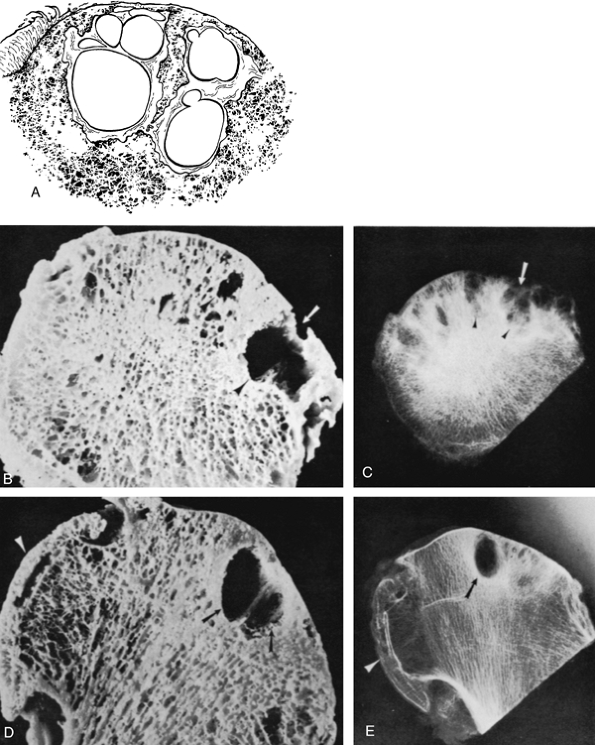 |
Figure 8-1 Subchondral bone cysts, pathologic and radiographic findings. A, A drawing reveals the typical appearance of multiple subchondral cysts of varying size in areas of cartilaginous degeneration or disappearance. They are surrounded by sclerotic bone. B and C, A photograph and radiograph of a macerated coronal section of a femoral head in a patient with osteoarthritis reveal multiple cystic lesions (arrowheads), which, in places, communicate with the articular cavity (arrows). D and E, In a different patient with a similar problem, a photograph and radiograph of a coronal section of the femoral head outline subchondral cysts (arrows), which in this instance do not obviously communicate with the articular cavity. They are located on the pressure segment (superolateral aspect) of the femoral head, whereas the osteophytes (arrowheads) are evident on the nonpressure segment. (A, D, and E from Resnick D. Diagnosis of Bone Joint Disorders. 4th ed. Philadelphia, WB Saunders, 2002, p 1282. B and C from Resnick D, Niwayama G, Coutts RD. Subchondral cysts [geodes] in arthritic disorders. Pathologic and radiographic appearance of the hip joint. AJR Am J Roentgenol 128: 799-806, 1977. Copyright 1977, American Roentgen Ray Society.) |
TABLE 8-3 TYPES OF OSTEOPHYTES | ||||||||||||||||||
|---|---|---|---|---|---|---|---|---|---|---|---|---|---|---|---|---|---|---|
| ||||||||||||||||||
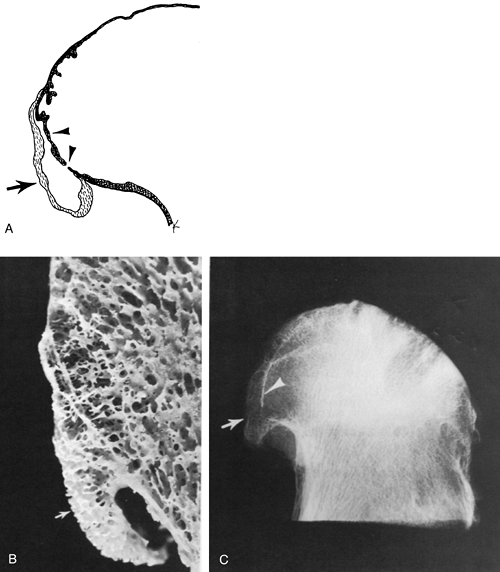 |
Figure 8-2 Marginal osteophytes, pathologic and radiographic findings. A, A diagram indicates the nature of the marginal osteophyte. It develops as a lip of bone (arrow) as a result of vascularization of the subchondral marrow with the inception of endochondral ossification. As it grows, it leaves behind a remnant of the original calcified cartilage (arrowheads). B and C, A photograph and radiograph of a small to moderate-sized marginal osteophyte (arrows) in these macerated coronal sections of the femoral head reveal the original calcified cartilaginous zone (arrowheads). (From Resnick D. Diagnosis of Bone Joint Disorders. 4th ed. Philadelphia, WB Saunders, 2002, p 1289 ) |
OA may be associated with degeneration of other articular structures, such as the fibrocartilage labrum, disks, and menisci.30,31,32 Degeneration of tendons, intraosseous ligaments, and membranes is also common, especially near the sites of attachment of these structures to bone (Fig. 8-3).
P.151
These may manifest radiographically as excrescences that are termed enthesophytes. Tendon and ligament calcification may also be noted.
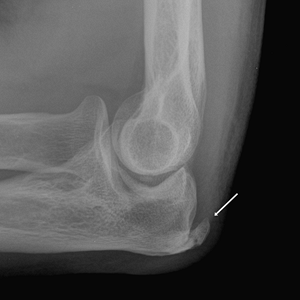 |
Figure 8-3 Enthesopathy in osteoarthritis. Lateral radiograph of an elbow reveals irregular osseous proliferation at the site of triceps attachment to bone (arrow). |
Osteoarthritis in Specific Locations
Hand and Wrist
OA of the proximal and distal interphalangeal joints of the hand (including the interphalangeal joint of the thumb) is extremely common, especially in middle-aged, postmenopausal women. Involvement of multiple digits of both hands is characteristic. Clinically, the altered digits may reveal malalignment, such as flexion deformity and radial or ulnar deviation at the interphalangeal joints. Bone outgrowths at the distal interphalangeal joints are termed Heberden nodes.33 Similar outgrowths at the proximal interphalangeal joints are termed Bouchard nodes.
Distal interphalangeal and proximal interphalangeal joints are frequently affected simultaneously and symmetrically; however, extensive alterations at distal interphalangeal joints may occur in the absence of proximal interphalangeal joint abnormalities, and less commonly, isolated abnormalities of proximal interphalangeal joints may be evident.
Radiographs reveal prominent osteophytes and joint space narrowing, providing close apposition of adjacent enlarged osseous surfaces. It is the closely applied, undulating articular surfaces that produce the diagnostic radiographic appearance of the disease, allowing it to be distinguished from erosive disorders, which produce separation of the involved bones. In OA, the wavy contour of the base of the distal phalanx resembles the wings of a bird (i.e., the seagull sign) (Fig. 8-4). The involved digits frequently reveal mild to moderate radial and ulnar subluxation at distal interphalangeal or proximal interphalangeal joints, producing a zigzag contour. At the margins of the affected joint, focal radiodense lesions (ossicles) are apparent overlying the joint capsule; they resemble intra-articular osseous bodies or fractured osteophytes.
 |
Figure 8-4 Osteoarthritis of the interphalangeal joints of the hand. A typical example of osteoarthritis of both distal interphalangeal and proximal interphalangeal articulations. Note the closely applied interdigitating osseous surfaces, capsular osteophytes, subchondral sclerosis, and wavy contour of the fingers as a result of medial and lateral phalangeal subluxations. On occasion, changes predominate at proximal interphalangeal articulations, resulting in clinically detectable Bouchard nodes. At the interphalangeal articulation of the thumb, prominent osteophytes, ossicles, joint space narrowing, and sclerosis are apparent. Note again the apposition of one bone with its neighbor. The typical distribution of osteoarthritis is illustrated here. Findings are apparent in distal interphalangeal, proximal interphalangeal, and, to a lesser extent, metacarpophalangeal articulations. |
Metacarpophalangeal joint involvement in OA is almost invariably associated with more prominent abnormalities at the proximal and distal interphalangeal joints. Uniform narrowing of one or more metacarpophalangeal interosseous spaces is most characteristic,34 and cystic lesions and osteophytes may also be apparent. Erosions are absent. One exception to these findings occurs in the first digit, in which isolated alterations at the first metacarpophalangeal joint can be a prominent manifestation of OA.
The radial distribution of OA of the wrist is well known. In the absence of significant accidental or occupational trauma, changes are usually confined to the trapeziometacarpal joint and trapezioscaphoid space of the midcarpal joint. At the
P.152
trapeziometacarpal joint, radiographic features of OA are characteristic. Radial subluxation of the metacarpal base, narrowing of the interosseous space, sclerosis, cystic changes in the subchondral bone, osteophytosis, and bone fragmentation become apparent (Fig. 8-5). OA of the trapezioscaphoid space is usually combined with degenerative changes at the trapeziometacarpal joint,35 although isolated abnormalities have also been reported.36,37,36 Typical radiographic features at this location are apparent in a unilateral or bilateral distribution; these include joint space narrowing and sclerosis of apposing surfaces of the trapezium, trapezoid, and scaphoid.
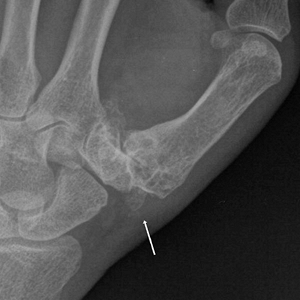 |
Figure 8-5 Osteoarthritis of the trapeziometacarpal joint. Joint space loss, subchondral sclerosis and cysts, and osteophytes are present at the trapeziometacarpal joint (arrow). |
OA localized to other compartments of the wrist is distinctly unusual in the absence of a history of trauma. However, fracture, subluxation, dislocation, or osteonecrosis about the wrist can lead to altered joint motion and can result in secondary OA. Typical examples include OA of the radiocarpal and midcarpal compartments after scaphoid injuries,39,40 OA of the radiocarpal and inferior radioulnar compartment after osteonecrosis of the lunate (Kienb ck disease), and OA of the inferior radioulnar compartment after subluxation of the distal part of the ulna. Arthrosis of the lunate-capitate space, leading to interosseous narrowing, sclerosis, and cyst formation, has been emphasized as an additional post-traumatic degenerative condition.41 This abnormality is usually combined with scapholunate separation, or dissociation, and narrowing of the radioscaphoid space.42 The resulting radiographic changes are termed the scapholunate advanced collapse pattern, or SLAC, wrist.42,43
Shoulder, Elbow, and Acromioclavicular Joints
OA of the glenohumeral joint has been considered unusual in the absence of trauma. Nontraumatic degenerative changes at this location are usually secondary to other disorders, such as alkaptonuria, acromegaly, epiphyseal dysplasia, calcium pyrophosphate dihydrate (CPPD), crystal deposition disease, apatite deposition disease (Milwaukee shoulder)44, and hemophilia.45,46,47 The most frequent abnormality in OA at this site is osteophyte formation along the articular margin of the humeral head and the line of attachment of the labrum to the glenoid fossa. These osteophytes predominate along the anteroinferior portions of the joint. Another abnormality seen in OA of the glenohumeral joint is eburnation, manifested as subchondral sclerosis, along the superior and middle portion of the articular surface of the humeral head (Fig. 8-6). Other alterations seen at this location include osseous excrescences with occasional areas of cystic change in the anatomic neck of the humerus. Osteophytes are commonly evident in and around the bicipital groove as well.48
OA of the elbow is uncommon and usually follows accidental or occupational trauma, as seen in miners and drillers. Typical radiographic findings include joint space narrowing, sclerosis, cysts, and osteophytes. Olecranon enthesophytes at the ulnar attachment of the triceps tendon may accompany these alterations (Fig. 8-3).
Degenerative changes of the acromioclavicular joint are nearly universal in the elderly. Radiographic examination reveals joint space loss, sclerosis of apposing osseous surfaces, marginal osteophytes, hypertrophy and inferior subluxation of the acromial end of the clavicle, and osseous proliferation on either the superior or inferior surface of the acromion49,50 (Fig. 8-7).
 |
Figure 8-6 Osteoarthritis of the glenohumeral joint. Joint space narrowing, sclelrosis, and formation of intra-articular bodies (arrow) are seen. |
Hip
OA of the hip is invariably associated with progressive and focal joint space narrowing. With the onset of this narrowing, the femoral head moves toward the acetabulum.
P.153
Three basic patterns of migration can be observed: superior migration, medial migration, and axial migration. With superior migration, the femoral head moves in an upward or superior direction with respect to the acetabulum. A medial migration pattern is evident when joint space loss is confined to the inner third of the joint. With axial migration, the femoral head migrates axially along the axis of the femoral neck, and there is diffuse loss of articular space. This classification system relies on changes seen on the frontal radiograph. Anterior or posterior migrations of the femoral head, as seen on lateral radiographs or with computed tomography or magnetic resonance imaging (MRI), may accompany these changes.
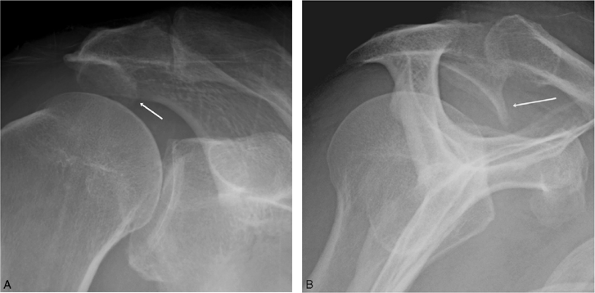 |
Figure 8-7 Subacromial enthesophytes. A, An anteroposterior radiograph of the shoulder in external rotation reveals marked enthesophytic proliferation about the inferior surface of the acromion (arrow). There is also joint space narrowing and subchondral sclerosis at the acromioclavicular joint. B, Scapular Y projection also shows the enthesophyte (arrow). |
Although the pattern of movement of the femoral head with respect to the acetabulum may be variable in OA, thereby influencing the distribution of morphologic changes, the basic radiographic and pathologic changes are similar. These include joint space narrowing, osteophytosis, buttressing, sclerosis, and cyst formation21,51,52,53,54,55,56,57,58,59,60,61,62,63,64,65,66,67 (Fig. 8-8). The cysts can be single or multiple and are of varying size; they are located on either the femoral or the acetabular side of the joint, or both. Large cystic lesions in the acetabulum are occasionally seen.
Synovial membrane alterations in OA are generally mild, although considerable osseous and cartilaginous debris may become embedded in the synovium of osteoarthritic hips, particularly in the recesses associated with the capsular reflection on the femoral neck.28 Hypertrophied synovium containing detritus may become prominent in these areas.65
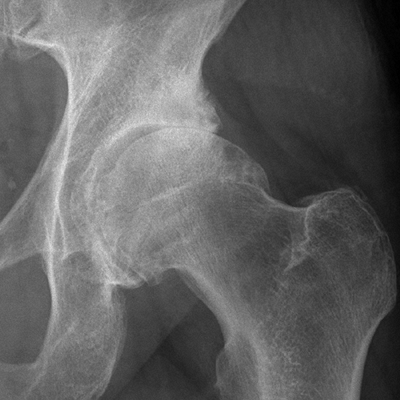 |
Figure 8-8 Osteoarthritis of the hip. Anteroposterior radiograph of the left hip demonstrates superior migration of the left femoral head, apposition of the femoral head and acetabulum, subchondral sclerosis and cyst formation on both the femoral and acetabular sides of the joint, buttressing of the femoral neck, and large osteophyte formation. These radiographic findings are diagnostic of osteoarthritis of the left hip. |
Arthrography is occasionally used to outline the location and extent of cartilage loss in OA of the hip,68 although similar abnormalities may be detected on routine radiography. Arteriography has been used to elucidate the vascular abnormalities of OA of the hip,69,70 which are manifested as increased number, length, and width of periarticular and intraosseous vessels. Venography may be used to identify a deviation in the normal pattern of venous drainage from the femoral head and neck.71,72,73,74 In OA, increased flow
P.154
initially occurs by way of the femoral shaft; subsequently, pooling of injected contrast material with decreased or absent venous outflow is seen. Radionuclide examination demonstrates increased uptake in periarticular osseous tissue.75,76 The scintigraphic pattern may be more sensitive, although relatively nonspecific, in detecting the presence and extent of OA. Computed tomography in conjunction with arthrography may be useful in detecting osteocartilaginous debris and in delineating the extent of anteversion of the femoral neck.77,78,79 MR imaging or MR arthrography may demonstrate areas of cartilage thinning, tears of the acetabular labrum, increased bone marrow signal on long TE pulse sequences indicative of reactive edema, and presence of intra-articular osteochondral loose bodies.80,81,82,83
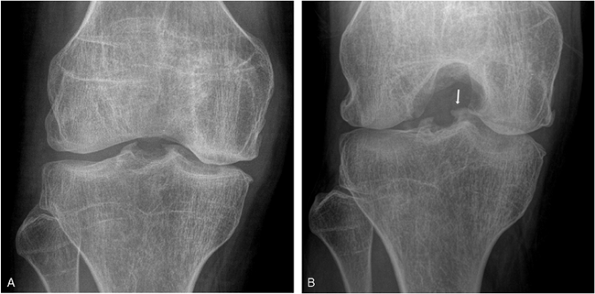 |
Figure 8-9 Osteoarthritis of the knee, usefulness of tunnel view. A, The anteroposterior radiograph reveals sclerosis of the lateral and medial tibial articular surfaces and the lateral femoral articular surface. The joint space does not appear diminished. B, On a tunnel view, the severity of joint space loss in both lateral and medial femorotibial compartments is evident. In addition, the intra-articular radiodense areas adjacent to the tibial spine are more apparent in this projection (arrow). |
Knee
Many factors contribute to the development of OA in the knee, including prior surgery or trauma, angular deformity, osteonecrosis, osteochondritis dissecans, obesity, and meniscal abnormality. All of these factors lead to an increased stress or force per unit area in the knee.
It is useful to regard the knee joint as consisting of three compartments: the medial femorotibial, the lateral femorotibial, and the patellofemoral. Radiographic changes usually predominate in one or two of these compartments, although pathologic changes are evident in all three areas. Routine radiography is somewhat limited in its sensitivity in detecting early changes.84,85 Weight-bearing or stress radiographic views better delineate joint space narrowing, sclerosis, cysts, and osteophytes. 84,85,86,87,88,89,90 Tunnel projections obtained with the knee in flexion may occasionally demonstrate cartilage loss or osteochondral lesions not well seen on routine views91 (Fig. 8-9).
 |
Figure 8-10 Valgus angulation of both the right and left knees with severe bilateral lateral compartment osteoarthritis. |
Bilateral or unilateral changes may be seen in the femorotibial compartments. Unicompartmental (medial femorotibial compartment)84,85 or bicompartmental (medial femorotibial and patellofemoral compartments) involvement is typically present in OA (Fig. 8-10). Less commonly, bicompartmental involvement of the lateral femorotibial and patellofemoral compartments is present. Joint space
P.155
narrowing varies from mild to severe. Subchondral bone sclerosis is more frequent in the proximal portion of the tibia than in the femur. Subchondral cysts are less common in the knee than in the hip and, when present, are usually small and seen in the proximal portion of the tibia. Subchondral cysts are associated with joint space narrowing and eburnation. On occasion, intra-articular surface irregularity and sharpening of the tibial spines are identified. Other radiographic abnormalities in OA of the knee include vacuum phenomenon within the articular space or within a diseased meniscus and meniscal calcification.
In OA, the patellofemoral compartment is commonly involved, although this involvement is usually combined with abnormalities in the femorotibial compartments. Rarely, abnormalities confined to the patellofemoral compartment are present. Radiographic manifestations of patellofemoral OA include joint space narrowing, sclerosis, and osteophytes, particularly on the patellar side of the space. Loss of articular space may be difficult to detect on lateral radiographs but is readily demonstrated on axial views. Osteophytes at the superior and inferior surface of the patella may, when present, become extremely large. Associated scalloped defects of the anterior cortex of the femur may become prominent.92,93 This finding appears to arise from pressure erosion of the femoral cortex by the patella and is located at the level the patella assumes on full extension of the knee.
Another degenerative process occurs on the anterior surface of the patella and consists of bone proliferation at the site of osseous attachment of the quadriceps tendon. This is an enthesopathic alteration probably related to abnormal stress on the ligamentous connection to the bone. It produces hyperostosis of the anterior patellar surface and has been termed the tooth sign.94
Angulation and subluxation at the knee joint are best demonstrated on weight-bearing or stress views of the knee. Varus angulation is more frequent than valgus angulation. The contralateral femorotibial compartment widens as the ipsilateral compartment narrows. Translation or subluxation of the tibia on the femur laterally with varus angulation and medially with valgus angulation is typical (Fig. 8-11).
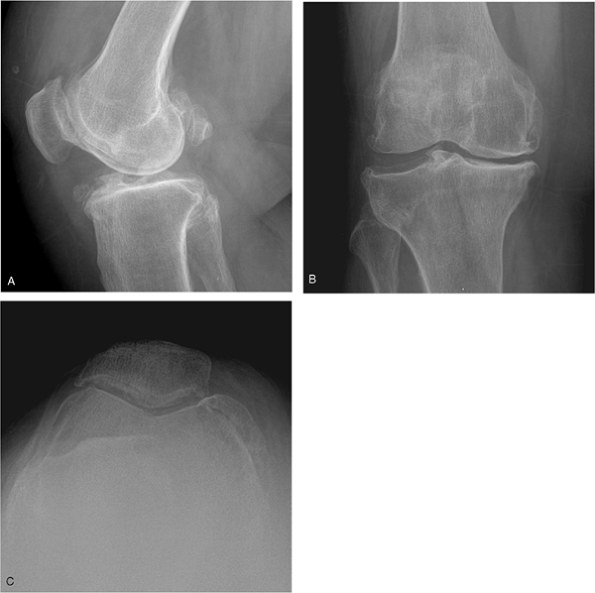 |
Figure 8-11 Severe tricompartmental osteoarthritis. A, Lateral, B, Frontal, and C, Merchant view radiographs of the left knee reveal joint space obliteration in the medial femoral tibial, lateral femoral tibial, and patellofemoral compartments; varus angulation and lateral subluxation of the tibia; and osteophyte formation. |
P.156
Cartilaginous and osseous debris arises from the disintegrating surfaces of the bones surrounding the knee joint. Such debris may exist as loose bodies or joint mice before being incorporated in the synovial membrane. Specialized techniques such as arthrography, computed tomography, or MR imaging may be useful in the detection and characterization of intra-articular osteochondral bodies.
In OA of the knee, cartilaginous fibrillation and erosion and osseous proliferation can also be observed in the sesamoid fabella. The anterior surface of the fabella may reveal flattening and sclerosis on radiography, and the peroneal nerve may be injured by an enlarged fabella.95
Patellofemoral pain syndrome is a term applied to a syndrome of pain and crepitus over the anterior aspect of the knee. It is most commonly seen in young adults.96,97 The cause of this syndrome is unclear, although it may be related to increased cartilage stress.98 The patella consists of three facets: the lateral, the medial, and a more medially located odd facet. The medial facet, particularly at the junction of the medial and odd facets, is a classic site of cartilage damage.
Ankle and Foot
OA of the ankle is uncommon in the absence of significant trauma. It may occur after fracture of the neighboring bones, especially when the ankle mortise is disrupted. Degeneration of the ankle may also develop whenever the talocalcaneal joints are altered, as may occur after congenital or surgical fusion. Joint space loss, sclerosis, and osteophytes may appear about the degenerating ankle joint (Fig. 8-12). Capsular traction can produce a talar beak on the dorsal aspect of the bone.99
Degenerative changes may develop at the first tarsometatarsal joint and may be manifested as joint space narrowing and sclerosis. Post-traumatic or, rarely, spontaneous changes may develop at other locations, such as the talonavicular portion of the anterior talocalcaneonavicular joint. Small osteophytes arise along the dorsal aspect of the apposing surfaces of the talus and navicular bones.100
Persistent hindfoot pain after a calcaneal fracture may result from development of OA in one or both subtalar joints. Plain films are usually inadequate in delineating the degenerative abnormalities; computed tomography provides much more information. Findings include joint space narrowing, irregularity and depression of the articular surfaces, bone sclerosis and cyst formation, and osteophytes.
Plantar and posterior enthesophytes are frequent radiographic findings that can be unassociated with clinical abnormalities. These excrescences develop at the osseous site of attachment of the Achilles tendon, plantar aponeurosis, and long plantar ligament. When they are well defined and sharply marginated, they usually represent no more than an incidental degenerative abnormality related to ligamentous or tendinous traction on bone. Alternatively, a poorly defined or fluffy plantar calcaneal bone outgrowth can be an important radiographic finding of ankylosing spondylitis, psoriasis, and reactive arthritis.101
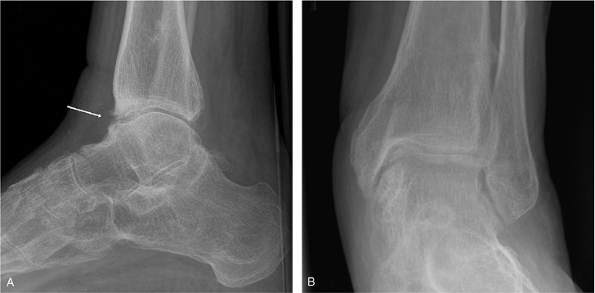 |
Figure 8-12 Osteoarthritis of the ankle. This middle-aged man developed progressive pain and swelling of the ankle after an injury many years before. Neurologic examination findings were normal. A, Lateral view demonstrates anterior osteophyte formation (arrow) and tibiotalar joint space narrowing. B, An anteroposterior radiograph of the ankle delineates joint space narrowing, sclerosis, fragmentation, and osteophytosis. |
OA of the first metatarsophalangeal joint (hallux rigidus and hallux valgus) is extremely common102,103,104 (Fig. 8-13). On radiographs, valgus angulation is frequently associated with pronation of the great toe and bone hypertrophy or osteophytosis, particularly on the medial aspect of the metatarsal head. The enlarged and irregular medial portion
P.157
of the metatarsal bone may contain cystic lesions and thickened trabeculae. The first tarsometatarsal joint may be obliquely oriented (metatarsus varus) in patients with hallux valgus.105,106 Changes in the other metatarsophalangeal joints may also become apparent, including subluxation or dislocation. OA of interphalangeal joints of the toes may be detected as an incidental finding on routine radiographs.
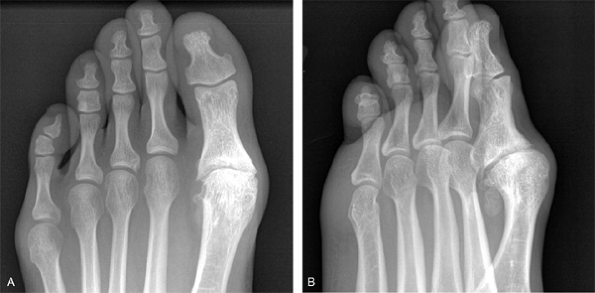 |
Figure 8-13 Osteoarthritis of the first metatarsophalangeal joint, hallux rigidus. A, Frontal and B, Oblique radiographs reveal considerable joint space narrowing, sclerosis, and osteophytosis about the first metatarsophalangeal articulation. |
Special Types of Osteoarthritis
Generalized Osteoarthritis
The concept of a generalized or polyarticular form of OA is not universally accepted, despite many descriptions of patients with OA in multiple locations, including the joints of the hands, wrists, spine, knees, and hips.107 When radiographs reveal evidence of degenerative changes in multiple sites, however, diagnoses other than generalized OA must be entertained. Multiple epiphyseal dysplasia, spondyloepiphyseal dysplasia, osteonecrosis, alkaptonuria, Paget disease, acromegaly, occupationally induced articular disorders, CPPD crystal deposition disease, gout, hemophilia, and inflammatory arthritides may lead to similar changes at multiple articular locations.
Inflammatory Osteoarthritis
A peculiar form of interphalangeal OA, characterized by acute inflammatory episodes with eventual ankylosis of some joints, has been described in middle-aged and elderly women.108 Although some reports have used the term erosive OA, the term inflammatory OA is preferable because the patients with typical clinical findings may not reveal erosive changes on the radiographs.109,110,111
The radiographic changes in inflammatory OA are characterized by a combination of bone proliferation and erosion. Proliferative changes, however, may occur in the absence of any erosive abnormalities. Osteophytosis is present, resembling that seen in noninflammatory OA and predominating in the proximal and distal interphalangeal joints. Joint space narrowing, with associated subchondral sclerosis, is common. Erosions, which commonly begin at the central portion of the joint in the form of sharply marginated, etched defects, are seen frequently in the interphalangeal articulations. Intra-articular bone ankylosis, virtually confined to the interphalangeal joints, is also seen in patients with inflammatory OA112,113 (Fig. 8-14). In the wrist, joint space narrowing and sclerosis occur on the radial aspect, between the trapezium and the base of the first metacarpal bone and also between the trapezium and the scaphoid; rarely, erosions are seen in these locations. These findings are identical to those in noninflammatory OA.
Complications of Osteoarthritis
In some degenerating joints, malalignment and subluxation of bone may become prominent. Asymmetric loss of joint space is characteristic and may produce varus or valgus angulation. Progressive subluxation may ensue, as evidenced by lateral displacement of the tibia on the femur, lateral displacement of the femoral head with respect to the acetabulum, and radial and proximal displacement of the first metacarpal base in relation to the trapezium.
Bone ankylosis is generally unusual in OA, with notable exceptions, including the ankylosis seen in inflammatory OA and that seen in the sacroiliac joints in noninflammatory OA. Bone bridging may also accompany degenerative changes in the symphyses.
P.158
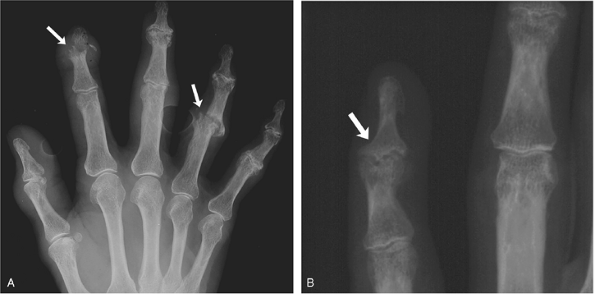 |
Figure 8-14 Inflammatory (erosive) osteoarthritis, interphalangeal joint abnormalities. A, Joint destruction (arrows) in the typical distribution of osteoarthritis is seen. B, In a more advanced case, disruption of the entire central aspect of the joint (arrow) is typical. Note the changes in the proximal interphalangeal articulation, which are identical to those of noninflammatory osteoarthritis. The eventual result may be intra-articular osseous fusion, as seen in the distal interphalangeal joint. |
Osteocartilaginous bodies may result from several sources: transchondral fractures, disintegration of the articular surfaces, and synovial metaplasia.114,115 In OA, fragmentation of the joint surface may occur, and this debris may remain on the joint surface or become dislodged in the joint cavity (Fig. 8-15). This debris may subsequently become embedded at a distal synovial site, eliciting a local inflammatory response. Radiographically dense areas may be present, which can increase or decrease in size. These osteochondral bodies may pass from the joint cavity into a neighboring communicating synovial cyst. The osteochondral bodies seen in OA are generally fewer than ten in number and vary in size, in contrast to idiopathic synovial osteochondromatosis, in which a larger number of uniformly sized osteochondral bodies are present.
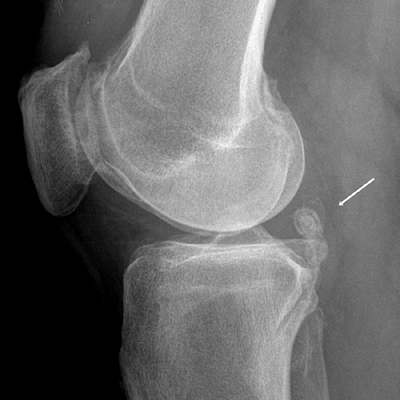 |
Figure 8-15 Osteochondral bodies as a complication of osteoarthritis. Lateral radiograph of the knee demonstrates osteochondral bodies (arrow) posterior to the joint. These osteochondral bodies typically migrate to the area of lowest pressure within the joint and may eventually become incorporated into the synovium. |
Osteoarthritis of The Spine
General Considerations
The term OA is applied to a variety of distinct processes of spinal joints. Because there are fundamental anatomic differences among the joints of the spine, however, each degenerates in a distinctive fashion. Characteristic clinical, pathologic, and radiologic changes accompany these degenerative processes.
Cartilaginous Joints
The major cartilaginous joint of the spine is the intervertebral disk, consisting of the nucleus pulposus, annulus fibrosus, and adjacent vertebral end plates. These components are intimately associated both anatomically and physiologically. The metabolism of the intervertebral disk in adults is primarily anaerobic116 and is dependent on diffusion of fluid either from the marrow of the vertebral bodies across the subchondral bone and cartilaginous end plate or through the annulus fibrosus from the surrounding blood vessels.
P.159
Intervertebral Osteochondrosis (Disk Degeneration)
Aging results in dehydration and loss of tissue resiliency in the intervertebral disk, especially in the nucleus pulposus.117,118,119,120,121 The nucleus pulposus appears desiccated and friable, which is a result of loss of water and proteoglycans. Clefts or crevices appear in the nucleus pulposus that extend to the annulus fibrosus.122,123
These earliest changes of osteochondrosis are identified on MR images, which also show dehydration of the nucleus pulposus. Although routine radiography is less sensitive than MR imaging, radiographic changes of intervertebral osteochondrosis include the appearance of characteristic linear or circular radiolucent areas (termed vacuum phenomena).124,125 These lucent areas are produced by gas, mainly nitrogen, accumulating in the clefts and are accentuated on radiography obtained during extension of the spine. Vacuum phenomena are a reliable indicator of disk degeneration, and their visualization virtually excludes the presence of tumor or infection (Fig. 8-16).
 |
Figure 8-16 Vacuum phenomena. As gas collects in the disk clefts, enlarging radiolucent areas (arrows) appear. The lucent areas are initially circular, but as they progress, linear shadows become evident. |
With more advanced intervertebral osteochondrosis, there is diminution of intervertebral disk height, with concomitant degeneration of the cartilaginous end plates and thickening of the adjacent trabeculae. This is manifested on the radiographs as disk space loss and bone eburnation. The sclerosis is generally well defined and linear or triangular; it extends to deeper portions of the vertebral body.126 Condensation of bone in both vertebral bodies surrounding an involved intervertebral disk is typical. These sclerotic areas are usually homogeneous, although they may contain radiolucent regions representing displaced disk material termed cartilaginous (Schmorl) nodes.
The pathologic and radiographic changes of intervertebral osteochondrosis may be present at any level in the spine, although changes are most prominent in the lower lumbar and cervical regions. Men are affected more commonly than are women.
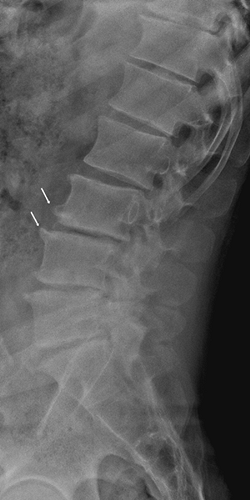 |
Figure 8-17 Spondylosis deformans. Lateral radiograph of the lumbar spine reveals osteophyte formation (arrows). These initially extend in a horizontal direction and then in a vertical one. Severe apophyseal joint osteoarthritis is also present. |
Spondylosis Deformans
The most obvious pathologic and radiographic OA of the spine is spondylosis deformans, which leads to vertebral outgrowths known as osteophytes (Fig. 8-17). Spinal osteophytosis
P.160
is extremely common.127,128 By the age of 50 years, approximately 60% of women and 80% of men demonstrate such excrescences. Bone outgrowths are more frequent in the older population and occur more often in men than in women. Any segment of the vertebral column may be affected; in the thoracic spine, right-sided outgrowths predominate and are presumably related to pulsations of the aorta on the left side, which inhibit bone production.
Disruption of the peripheral fibers of the annulus fibrosus is generally accepted to be the initiating event in this disorder. Once disruption occurs, minor degrees of anterior and anterolateral disk displacement is possible. This leads to traction at the site of osseous attachment of the outermost fibers of the annulus fibrosus, known as Sharpey fibers, to the vertebral body. Osteophytes develop at this location, several millimeters from the disk-vertebral body junction. The outgrowths initially extend in a horizontal direction and then turn vertically.
Uncovertebral Joint Arthrosis
Uncovertebral joints (joints of Luschka) are present in the lower five cervical vertebrae (C3 to C7). These vertebral bodies contain bone ridges on each side of their superior surfaces, the uncinate or lunate processes. The uncovertebral joints exist between the superior process of the lower vertebra and the inferior portion of the adjacent vertebral body. The joints have anatomic features of both cartilaginous and synovial articulations.129,130
With increasing degeneration of intervertebral disk tissue, there is progressive loss of disk integrity, and the uncinate process of the lower vertebra and the inferior body of the upper vertebra approach each other. Eventually, the articular processes are pressed firmly together and the articulation degenerates.131 Osteophytes may develop that may impinge on nerve roots or the vertebra at the costotransverse foramen. Radiography in the frontal projection reveals enlarged uncinate processes and joint space narrowing. Similar changes are seen on the oblique and lateral views.
Synovial Joints
Apophyseal Joint Osteoarthritis
The apophyseal joints of the vertebral column are a frequent site of OA. Although any spinal level may be affected, changes commonly predominate in the middle and lower cervical spine, the upper and midthoracic spine, and the lower lumbar spine.132,133,134 The degenerative changes are induced by abnormal stress across a joint.135
The pathologic and radiographic changes of OA of the apophyseal joints are similar to those occurring in other synovial joints136,137 and include cartilaginous erosion and denudation manifested radiographically as joint space narrowing. Bone eburnation and osteophytosis are common and may be accompanied by intra-articular osteocartilaginous bodies. Capsular laxity allows subluxation of one vertebral body on another. Bone ankylosis of the joint may ensue.
Fibrous Joints and Entheses
Ligamentous Degeneration
Degenerative abnormalities may become evident in the anterior longitudinal ligament, posterior longitudinal ligament, ligamenta flava, interspinous ligaments, supraspinous ligament, intertransverse ligaments, ligamentum nuchae, and iliolumbar ligaments.
Supraspinous and interspinous ligament abnormalities frequently coexist. Extensive lordosis, or disk space loss, leads to close approximation and contact of spinous processes and to degeneration of intervening ligaments. The kissing spinous processes develop reactive eburnation (Baastrup disease)138,139 and may be associated with considerable pain.140,141 The characteristic radiographic abnormality in Baastrup disease is the abnormal contact of apposing spinous processes, combined with sclerosis in the superior and inferior portions of adjacent processes. These changes are best demonstrated on lateral radiographs of the flexed and extended spine142,143 (Fig. 8-18).
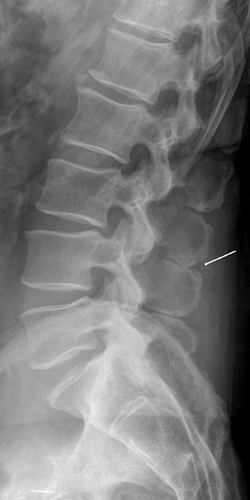 |
Figure 8-18 Baastrup disease. Lateral radiograph of the lumbar spine shows enlarged spinous processes that are flattened and sclerotic in their inferior and superior portions (arrow). |
Ossification to various degrees in the ligamentum nuchae can be seen and is of no clinical significance.
P.161
Ossification may also be present in the iliolumbar ligament and is of unknown pathogenesis and significance. Such ligamentous ossification, however, is more frequent in patients with diffuse idiopathic skeletal hyperostosis.
Complications of Osteoarthritis of the Spine
Alignment Abnormalities
Segmental Instability. Lateral radiographs in the neutral position and with the spine in flexion and extension can be used to evaluate the degree and pattern of motion in the lumbar spine. Radiographic findings suggestive of instability include the presence of gas within the intervertebral disk, osteophytes on adjacent vertebral bodies below the rims of the end plate (i.e., traction spurs), and evidence of a radial spur in the intervertebral disk during diskography. Radiographs should be considered to demonstrate instability when they reveal forward or backward displacement of one vertebra on another, an abrupt change in the length of the pedicles, narrowing of the intervertebral foramina, and loss of height of an intervertebral disk.144 On frontal radiographs obtained with the patient bending first in one direction and then another, additional abnormalities include asymmetry in the person's ability to bend in both directions, loss of normal vertebral rotation and tilt, abnormal degree of disk closure or opening, malalignment of spinous processes and pedicles, and lateral translation of one vertebra on another as a result of an abnormal degree of rotation.145
Degenerative Spondylolisthesis. The term spondylolysis refers to an interruption of the pars interarticularis of the vertebra. Spondylolysis is generally considered to represent an acquired abnormality characterized by a mechanical failure of bone related to abnormal vertebral stress. The term spondylolisthesis refers to displacement of one vertebral body on another, which may be secondary to defects in the neural arch of the vertebra or to OAs of the spine. Radiographic findings of degenerative spondylolisthesis include OA of apophyseal joints (joint space narrowing, sclerosis, and osteophytes), with forward slipping of the superior vertebra on the inferior one.
Another pattern of degenerative spondylolisthesis is associated with intervertebral osteochondrosis (disk degeneration). Intervertebral osteochondrosis results in a decrease in height of the involved disk space, closer approximation of adjacent vertebral bodies, and gliding or telescoping of the corresponding articular processes. Because of the normal oblique inclination of the superior articular processes, there is posterior displacement of the superior vertebra relative to the inferior one.146,147,148 Radiographic findings include the typical changes of intervertebral osteochondrosis and apophyseal joint instability and subluxation. In the posterior joints, the initial radiographic appearance is characterized by asymmetry of joint space and tilting of one articular process on another; subsequently, joint displacement is observed, and the inferior articular processes of the superior vertebra extend below the articular surfaces of the superior process.
Senile Kyphosis. Exaggerated thoracic kyphosis is common among the elderly. This may be secondary to osteoporosis (osteoporotic kyphosis) or, less commonly, to degeneration of the annulus fibrosus (senile kyphosis). The radiographic features of senile kyphosis resemble those of intervertebral osteochondrosis, although the disk space narrowing and reactive sclerosis are in a more anterior position in senile kyphosis. Before osseous fusion of vertebral bodies, osteophytosis on the anterior surface of the vertebrae is common; after osseous fusion, the osteophytes may be resorbed.
Degenerative Scoliosis. OAs of the spine do not typically lead to scoliosis, although they may appear during the course of scoliosis and aggravate the condition. Intervertebral osteochondrosis, spondylosis deformans, and OA predominate along the concave portion of the curve.
Intervertebral Disk Displacement
The intervertebral disk is normally a load-bearing structure with hydrostatic properties related to its high water content.149 As the nucleus pulposus is subjected to increased pressure, it attempts to prolapse from its confined space. The intervertebral disk may be prolapsed anteriorly (spondylosis deformans), posteriorly (intraspinal herniation), or superiorly and inferiorly (cartilaginous nodes).
Posterior displacement of disk material is of great clinical significance because of the intimate relationship between the intervertebral disk and important neurologic structures. Factors that predispose to posterior disk displacement include a somewhat posterior position of the nucleus pulposus, the existence of fewer and weaker annular fibers in this region, and a posterior longitudinal ligament150 that is not as strong as the anterior longitudinal ligament. The following terms are used to indicate the extent of displacement of the intervertebral disk:
Annular bulge: the annular fibers remain intact but protrude in a localized or diffuse manner into the spinal canal.
Disk prolapse: the displaced nucleus pulposus extends through some of the fibers of the annulus fibrosus but is still confined by the intact outermost fibers.
Disk extrusion: the displaced nucleus pulposus penetrates all of the fibers of the annulus fibrosus and lies beneath the posterior longitudinal ligament.
Disk sequestration: the displaced nucleus pulposus penetrates or extends around the posterior longitudinal ligament and lies within the epidural space, or the displaced nucleus pulposus, although not extending through this ligament, migrates for a considerable distance in a cephalic or caudal direction as a fragment that is separate from the remaining portion of the intervertebral disk.
Although diagnosis of posterior displacement of portions of the intervertebral disk may occasionally be established with routine radiography because of the presence of calcification, other methods are generally required. These include MR imaging, computed tomography with or without intrathecal administration of a contrast agent, and myelography.
P.162
Intervertebral Disk Calcification
Many systemic disorders are associated with intervertebral disk calcification. However, in most of these conditions, multiple intervertebral disks are involved. In adults, degenerative calcific deposits may occur in the annulus fibrosus, nucleus pulposus, and cartilaginous end plates; these are usually confined to one or two levels. These changes are generally seen in elderly men and are most apparent at the midthoracic and upper lumbar levels.
Spinal Stenosis
Degenerative disorders of the vertebral column lead to hypertrophic alterations about the involved joints that may compromise spinal contents. Such changes are most common in the lumbar and cervical regions and can be further subdivided on the basis of anatomic location of the stenosis.
Central stenosis occurs in the region of the central canal. Its causes may be developmental or acquired as a result of hypertrophic changes in the joints or ligaments surrounding the central canal. Computed tomography or MR findings in the transaxial plane include distortion of the normal configuration of the canal, compression of the thecal sac, and obliteration of the epidural fat.151
Stenosis of the intervertebral foramen may result from disk herniation, osteophytosis of the vertebral bodies or articular process, or various inflammatory and neoplastic diseases. MR imaging and computed tomography are superior to myelography in demonstrating foraminal encroachment and displacement or distortion of the exiting nerve and surrounding epidural fat.152 These imaging methods are also superior to myelography in demonstrating soft tissue or bone masses.153
The subarticular or lateral recess may be compromised by hypertrophy about the apophyseal joint, which may lead to displacement or distortion of adjacent neural elements. These changes are best demonstrated in the transaxial plane with MR imaging or computed tomography.
Diffuse Idiopathic Skeletal Hyperostosis
Diagnostic Criteria
Diffuse idiopathic skeletal hyperostosis (DISH) is a skeletal disorder producing characteristic alterations in both spinal and extraspinal structures.154,155 There are three radiographic criteria for the diagnosis of spinal involvement in DISH:154
the presence of flowing calcification and ossification along the anterolateral aspect of at least four contiguous vertebral bodies, with or without associated localized pointed excrescences at the intervening vertebral body-intervertebral disk junction (Fig. 8-19);
the presence of relative preservation of intervertebral disk height in the involved vertebral segment and the absence of extensive radiographic changes of degenerative disk disease, including vacuum phenomenon and vertebral body marginal sclerosis; and
the absence of apophyseal joint bone ankylosis and sacroiliac joint erosion, sclerosis, or intra-articular osseous fusion.
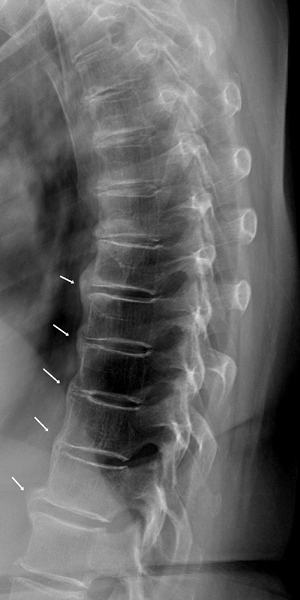 |
Figure 8-19 Thoracic spine alterations in DISH. Ossification of the anterior longitudinal ligament over five contiguous vertebral bodies. The anterior longitudinal ligament attaches to the midportion of the vertebral bodies (arrows), and ossification within it may be separated from the vertebral bodies at other portions by a lucent area that may measure 1 to 3 mm. |
All three radiographic criteria must be fulfilled for a definitive diagnosis of DISH to be established. Each is used to eliminate other spinal disorders that potentially could be confused with DISH, including spondylosis deformans, intervertebral osteochondrosis, and ankylosing spondylitis.
Quantitation of Radiologic Changes
The use of radiography to detect and stage the articular changes of OA is widespread. Conventional radiography, however, is neither sensitive nor specific to the earliest changes of OA. With use of this technique, up to 40% of
P.163
the population may be diagnosed as having OA while still asymptomatic, and others who have the clinical signs and symptoms of OA have normal findings on radiography. Furthermore, there are differences in interpretation of diagnostic radiographic signs.
A variety of radiographic grading systems have been proposed. No single global staging system may be suitable for the assessment of OA at all sites, however. In the hip joint, the most common radiographic sign seen in OA is joint space narrowing, associated with superior medial or axial migration of the femoral head. With greater severity of the disease, there may be flattening of the femoral head as well as osteophytes seen in the acetabulum and femoral head and neck. Joint space narrowing has been more strongly associated with pain than the presence of osteophytes has, suggesting to some that joint space narrowing may be of more importance than the presence of osteophytes in defining hip OA.156,157,158,159,160,161,162,163,164,165
In the knee, a grading system has been developed to include joint space narrowing, graded on a scale of 0 to 3; individual features of an osteophyte, graded on a scale of 0 to 3; and sclerosis, graded as being present or absent. Preliminary studies suggest that the best variables in assessing progression of OA of the knee are joint space narrowing followed by the presence of osteophytes.165
Buckland-Wright166,167 proposed a method of quantitation of radiographic changes using magnification radiography. In this technique, a micron-sized x-ray focal spot is used. The joint to be examined is placed close to the x-ray tube and separated by a distance of 1 to 2 meters from the film. This results in a magnified image with high spatial resolution. A standardized protocol for radiographic imaging of different joints has been proposed. Furthermore, methods of standardization and quantification of measurements to ensure accurate interpretation have also been proposed. The most sensitive radiographic signs for detecting the presence of OA are osteophytes, subchondral sclerosis, and juxta-articular lucencies. It is suggested that the only reliable and sensitive parameters for assessing the progression of disease are changes in the number and size of osteophytes and joint space narrowing.
Summary
OA is a common and widespread affliction in extraspinal locations. Abnormalities predominate in the cartilaginous and osseous structures. Typical findings include joint space loss, eburnation, cyst formation, and osteophytosis. Subluxation, malalignment, fibrous ankylosis, and intra-articular osseous and cartilaginous bodies may complicate OA.
The most common extraspinal sites of OA are the interphalangeal and metacarpophalangeal joints of the hand, the first carpometacarpal and trapezioscaphoid areas of the wrist, the acromioclavicular and sternoclavicular joints, the hip, the knee, and the tarsometatarsal and metatarsophalangeal joints of the great toe. At each of these sites, characteristic radiographic findings are present.
Two special forms of OA have been described. Generalized OA may affect multiple articulations. Inflammatory OA is associated with clinical, pathologic, and radiographic manifestations of joint inflammation, including erosions and bone ankylosis, although its distribution is virtually identical to that of noninflammatory digital OA.
OAs of the spine include a variety of processes, each with characteristic radiographic manifestations. Although any one process may predominate, they frequently occur together. These disorders include intervertebral osteochondrosis, which is characterized by vacuum phenomena, disk space narrowing, and reactive sclerosis; spondylosis deformans, which is characterized by osteophytosis; OA, which is characterized by joint space narrowing, bone sclerosis, and hypertrophy; and ligamentous degeneration, which is associated with calcification and ossification. Several complications may occur in the course of such degenerative spine disease, including disorders of alignment, intervertebral disk displacements, disk calcification and ossification, and spinal stenosis.
DISH is a skeletal disorder producing characteristic radiographic findings at both spinal and extraspinal sites. This disorder shares many features with spondylosis deformans, although a qualitative difference between these two conditions is present; the degree of disk displacement and the amount of bone proliferation are greater in DISH than in spondylosis deformans. Spinal ligament calcification and ossification occur in DISH and are not prominent features of spondylosis deformans.
A variety of schemes using conventional and magnification radiography and MR imaging have been proposed to quantitate the changes of OA and to detect and stage progression of the disease. Plain radiography is not as sensitive as magnetic resonance imaging to early changes of OA. However, radiographs remain a valuable clinical and research tool for following the progression of OA.
References
1. Garrod AE. Rheumatoid arthritis, osteoarthritis and arthritis deformans. In: Allbutt TC, Rolleston HD, eds. A System of Medicine. Rev ed. Vol 3. London, Macmillan, 1907.
2. Nichols EH, Richardson FL. Arthritis deformans. J Med Res 21:149, 1909.
3. Mitchell NS, Curess RL. Classification of degenerative arthritis. Can Med Assoc J 117:763 765, 1977.
4. Trueta J. Studies of the Development and Decay of the Human Frame. Philadelphia, WB Saunders, 1968.
5. Trueta J, Harrison MHM. The normal vascular anatomy of the femoral head in the adult man. J Bone Joint Surg Br 35:442 461, 1953.
6. Ingelmark BE. The nutritive supply and nutritional value of synovial fluid. Acta Orthop Scand 20:144 155, 1950.
7. Eckholm R, Norback B. On the relationship between articular changes and function. Acta Orthop Scand 21:81 98, 1951.
8. Harrison MHM, Schajowicz F, Trueta J. Osteoarthritis of the hip: a study of the nature and evolution of the disease. J Bone Joint Surg Br 35:598 626, 1953.
9. Redler I. A scanning electron microscopic study of human normal and osteoarthritic articular cartilage. Clin Orthop 103:262 268, 1974.
P.164
10. Nimni M, Deshmukh K. Differences in collagen metabolism between normal and osteoarthritic human articular cartilage. Science 181:751 752, 1973.
11. Weiss C, Mirow S. An ultrastructural study of osteoarthritic changes in articular cartilage of human knees. J Bone Joint Surg Am 54:954 972, 1972.
12. Phemister DB. Bone growth and repair. Ann Surg 102:261 285, 1935.
13. Cameron HU, Fornasier VL. Trabecular stress fractures. Clin Orthop 111:266 268, 1975.
14. Todd RC, Freeman MAR, Ririe CJ. Isolated trabecular fatigue fractures in the femoral head. J Bone Joint Surg Br 54:723 728, 1972.
15. Urovitz EPM, Fornasier VL, Risen MI, et al. Etiological factors in the pathogenesis of femoral trabecular fatigue fractures. Clin Orthop 127:275 280, 1977.
16. Havdrup T, Hulth A, Telhag H. The subchondral bone in osteoarthritis and rheumatoid arthritis of the knee. A historical and microradiographical study. Acta Orthop Scand 47:345 350, 1976.
17. Kusakabe A. Subchondral cancellous bone in osteoarthrosis and rheumatoid arthritis of the femoral head. A quantitative histological study of trabecular remodelling. Arch Orthop Unfallchir 88:185 197, 1977.
18. Jeffery AK. Osteogenesis in the osteoarthritic femoral head. A study using radioactive 32P and tetracycline bone markers. J Bone Joint Surg Br 55:262 272, 1973.
19. Landells JW. The bone cysts of osteoarthritis. J Bone Joint Surg Br 35:643 649, 1953.
20. Rhaney K, Lamb DW. The cysts of osteoarthritis of the hip. A radiological and pathological study. J Bone Joint Surg Br 37:663 675, 1955.
21. Ondrouch AS. Cyst formation in osteoarthritis. J Bone Joint Surg Br 45:755 760, 1963.
22. Crane AR, Scarano JJ. Synovial cysts (ganglia) of bone. J Bone Joint Surg Am 49:355 361, 1967.
23. Cruickshank B, Macleod JG, Shearer WS. Subarticular pseudocysts in rheumatoid arthritis. J Fac Radiol Lond 5:218 226, 1954.
24. Bugnion JP. Lesions nouvelles du poignet: pseudokystes necrobiotiques, kystes par herniations capsulaires, arthrite chronique degenerative par osteochondrose marginale. Acta Radiol (Stockh) 90:5, 1951.
25. Resnick D, Niwayama G, Coutts RD. Subchondral cysts (geodes) in arthritic disorders. Pathologic and radiographic appearance of the hip joint. AJR 128:799 806, 1977.
26. Morrissy RT. Acetabular cyst in a child. A case report. J Bone Joint Surg Am 61:609 612, 1979.
27. Jaffe HL. Metabolic, Degenerative and Inflammatory Diseases of Bones and Joints. Philadelphia, Lea & Febiger, 1972.
28. Lloyd-Roberts GC. The role of capsular changes in osteoarthritis of the hip joint. J Bone Joint Surg Br 35:627 642, 1953.
29. Martel W, Braunstein EM. The diagnostic value of buttressing of the femoral neck. Arthritis Rheum 21:161 164, 1978.
30. Hansson T, Oberg T. Arthrosis and deviation in form in the temporomandibular joint. A macroscopic study on a human autopsy material. Acta Odont Scand 35:167 174, 1977.
31. Noble J, Hambien DL. The pathology of the degenerate meniscus lesion. J Bone Joint Surg Br 57:180 186, 1975.
32. Chad K. Horizontal (cleavage) tears of the knee joint menisci in the elderly. J Am Geriatr Soc 20:430, 1972.
33. Heberden W. Commentaries on the History and Cure of Diseases. London, Payne, 1802.
34. Martel W, Snarr JW, Horn JR. The metacarpophalangeal joints in interphalangeal osteoarthritis. Radiology 108:1 7, 1973.
35. North ER, Eaton RG. Degenerative joint disease of the trapezium: a comparative radiographic and anatomic study. J Hand Surg 8:160 166, 1983.
36. Carstam N, Eiken O, Andren L. Osteoarthritis of the trapezio-scaphoid joint. Acta Orthop Scand 39:354 358, 1968.
37. Patterson AC. Osteoarthritis of the trapezioscaphoid joint. Arthritis Rheum 18:375 379, 1975.
38. Dryer RF, Buckwalter JA. Isolated scaphotrapezial trapezoidal arthrosis. Orthopedics 3:213, 1980.
39. Mack GR, Bosse MJ, Gelberman RH, et al. The natural history of scaphoid nonunion. J Bone Joint Surg Am 66:504 509, 1984.
40. Ruby LK, Stinson J, Belsky MR. The natural history of scaphoid nonunion. A review of fifty-five cases. J Bone Joint Surg Am 67:428 432, 1985.
41. Jonsson K, Sigfusson BF. Arthrosis of the lunatecapitate joint. Acta Radiol 24:415 418, 1983.
42. Watson HK, Ballet FL. The SLAC wrist: scapholunate advanced collapse pattern of degenerative arthritis. J Hand Surg 9: 358-365, 1984.
43. Watson HK, Ryu J. Degenerative disorders of the carpus. Orthop Clin North Am 15:337 353, 1984.
44. McCarty DJ, Halverson PB, Carrera GF, et al. Milwaukee shoulder association of microspheroids containing hydroxyapatite crystals, active collagenase, and neutral protease with rotator cuff defects. Arthritis Rheum 24:464 473, 1981.
45. Barton NJ. Arthrodesis of the shoulder for degenerative conditions. J Bone Joint Surg Am 54:1759 1764, 1972.
46. Neer CS II. Degenerative lesions of the proximal humeral articular surface. Clin Orthop 20:116 125, 1961.
47. Neer CS II. Replacement arthroplasty for glenohumeral osteoarthritis. J Bone Joint Surg Am 56:1 13, 1974.
48. Cone RO, Danzig L, Resnick D, et al. The bicipital groove: radiographic, anatomic, and pathologic study. AJR 141:781 788, 1983.
49. Zanca P. Shoulder pain: involvement of the acromioclavicular joint (analysis of 1,000 cases). AJR 171:493 506, 1971.
50. Olah J. Das R ntgenbild des akromioklavikularen Gelenkes im Alter. Rofo 127:334 337, 1977.
51. Hermodsson I. Roentgen appearance of coxarthrosis. Relation between the anatomy, pathologic changes, and roentgen appearance. Acta Orthop Scand 41:169 187, 1970.
52. Murray RO. The etiology of primary osteoarthritis of the hip. Br J Radiol 38:810 824, 1965.
53. Gofton J. Studies in osteoarthritis of the hip. Part I. Classification. Can Med Assoc J 104:679 683, 1971.
54. Solomon L. Patterns of osteoarthritis of the hip. J Bone Joint Surg Am 58:176 183, 1976.
55. Hermodsson I. Roentgen appearance of arthritis of the hip. Acta Radiol 12:865 868, 1972.
56. Resnick D. Patterns of migration of the femoral head in osteoarthritis of the hip. Roentgenographic-pathologic correlation and comparison with rheumatoid arthritis. AJR 124:62 74, 1975.
57. Lloyd-Roberts GC. Osteoarthritis of the hip. A study of the clinical pathology. J Bone Joint Surg Br 37:8 47, 1955.
58. Dihlmann W, Hopf A. Das Wiberg-Zeichen, ein Hinweis auf Gestorte Huftgelenksmechanik (Spezielle, weniger beachtete R ntgenbefunde am Stutz- und Gleitgewebe 3). Fortschr Geb Roentgenstr Nuklearmed Erganzungsband 115:572 581, 1971.
59. Ferguson AB Jr. The pathology of degenerative arthritis of the hip and the use of osteotomy in its treatment. Clin Orthop 77: 84-97, 1971.
60. Kusakabe A. Subchondral cancellous bone in osteoarthritis and rheumatoid arthritis of the femoral head. A quantitative histological study of trabecular remodelling. Arch Orthop Unfallchir 88:185 197, 1977.
61. Byers PD, Contepomi CA, Farkas TA. Postmortem study of the hip joint. II. Histological basis for limited and progressive cartilage alterations. Ann Rheum Dis 35:114 121, 1976.
62. Byers PD, Contepomi CA, Farkas TA. Postmortem study of the hip joint including the prevalence of the features of the right side. Ann Rheum Dis 19:15 31, 1970.
63. Mankin HJ, Doftman H, Lippiello L, et al. Biochemical and metabolic abnormalities in articular cartilage from osteoarthritic human hips. II. Correlation of morphology with biochemical and metabolic data. J Bone Joint Surg Am 53:523 537, 1971.
64. Vignon E, Arlot M, Meunier P, et al. Quantitative histological changes in osteoarthritic hip cartilage. Morphometric analysis of 29 osteoarthritic and 26 normal human femoral heads. Clin Orthop 103:269 278, 1974.
65. Jeffery AK. Osteophytes and the osteoarthritic femoral head. J Bone Joint Surg Br 57:314 324, 1975.
66. Meachim G, Hardinge K, Williams DR. Methods for correlating pathological and radiological findings in osteoarthritis of the hip. Br J Radiol 45:670 676, 1972.
P.165
67. Kashimoto T, Friedenberg ZB. A study of radiographic variations of the hip joint. Acta Orthop Scand 48:487 493, 1977.
68. Tanaka S, Ito T, Yamamoto K. Arthrography in osteoarthritis of the hip. AJR 124:91 95, 1975.
69. Hipp E. Die Gefasse des H ftkopfes: Anatomie, Angiographie und Klinik. Z Orthop Suppl 96, 1962.
70. Mussbichler H. Arteriographic findings in patients with degenerative osteoarthritis of the human hip. Radiology 107:21 27, 1973.
71. Arnoldi CC, Linderholm H, Mussbichler H. Venous engorgement and intraosseous hypertension in osteoarthritis of the hip. J Bone Joint Surg Br 54:409 421, 1972.
72. Phillips RS, Bulmar JH, Hoyle G, et al. Venous drainage in osteoarthritis of the hip. A study after osteotomy. J Bone Joint Surg Br 49:301 309, 1967.
73. Phillips RS. Phlebography in osteoarthritis of the hip. J Bone Joint Surg Br 48:280 288, 1966.
74. Arnold CC, Djurhuus JC, Heerfordt J, et al. Intraosseous phlebography, intraosseous measurements and 99mTc-polyphosphate scintigraphy in patients with various painful conditions in the hip and knee. Acta Orthop Scand 51:19 28, 1980.
75. Danielsson LG, Dymling JF, Heripret G. Coxarthrosis in man studied with external counting of Sr85 and Ca47. Clin Orthop 31:184 199, 1963.
76. Kolar J, Vyhnanek L, Drapelova D, et al. Degenerativni chorbykloubni pri osteologicke diagnostice se 85Sr. Fysiatr Revmatol Vestn 45:65 72, 1967.
77. Reikeras O, Bjerkreim I, Kolbenstevedt A. Anteversion of the acetabulum and femoral neck in normals and in patients with osteoarthritis of the hip. Acta Orthop Scand 54:18 23, 1983.
78. Reikeras O, Hoiseth A. Femoral neck angles in osteoarthritis of the hip. Acta Orthop Scand 53:781 784, 1982.
79. Terjesen T, Benum P, Anda S, et al. Increased femoral anteversion and osteoarthritis of the hip joint. Acta Orthop Scand 53:571 575, 1982.
80. Hodler J, Trudell D, Pathria MN, et al. Width of the articular cartilage of the hip: quantification by using fat suppression spin-echo MR imaging in cadavers. AJR 159:351 355, 1992.
81. Lecovet FE, Vande Berg BC, Malghem J, et al. MR imaging of the acetabular labrum: variations in 200 asymptomatic hips. AJR 167:1025 1028, 1996.
82. Czerny C, Hofmann S, Neuhold A, et al. Lesions of the acetabular labrum: accuracy of MR imaging and MR arthrography in detection and staging. Radiology 200:225 230, 1996.
83. Petersilge CA, Haque MA, Petersilge WJ, et al. Acetabular labral tears: evaluation with MR arthrography. Radiology 200:231 235, 1996.
84. Thomas RH, Resnick D, Alazraki NP, et al. Compartmental evaluation of osteoarthritis of the knee. A comparative study of available diagnostic modalities. Radiology 116:585 594, 1975.
85. Ahlback S. Osteoarthrosis of the knee. A radiographic investigation. Acta Radiol Diagn (Stockh) Suppl 277:7 72, 1968.
86. Gibson PH, Goodfellow JW. Stress radiography in degenerative arthritis of the knee. J Bone Joint Surg Br 68:608 609, 1986.
87. Harris WR, Kostuik JP. High tibial osteotomy for osteoarthritis of the knee. J Bone Joint Surg Am 52:330 336, 1970.
88. Leach RE, Gregg T, Siber FJ. Weightbearing radiography in osteoarthritis of the knee. Radiology 97:265 268, 1970.
89. Leonard LM. The importance of weight-bearing x-rays in knee problems. J Maine Med Assoc 62:101 106, 1971.
90. Marklund T, Mynerts R. Radiographic determination of cartilage height in the knee joint. Acta Orthop Scand 45:752 755, 1974.
91. Resnick D, Vint V. The tunnel view in assessment of cartilage loss in osteoarthritis of the knee. Radiology 137:547 548, 1980.
92. Doppman JL. The association of patellofemoral erosion and synovial hypertrophy. A diagnostic entity. Radiology 82:240 245, 1964.
93. Alexander C. Erosion of the femoral shaft due to patellofemoral osteoarthritis. Clin Radiol 11:110 113, 1960.
94. Greenspan A, Normal A, Tchang FK. Tooth sign in patellar degenerative disease. J Bone Joint Surg Am 59:483 485, 1977.
95. Mangieri JV. Peroneal nerve injury from an enlarged fabella. A case report. J Bone Joint Surg Am 55:395 397, 1973.
96. Fredericson, M., Yoon, K. Physical examination and patellofemoral pain syndrome. Am J Phys Med Rehab 59:234 243, 2006.
97. Post, WR. Patellofemoral pain: results of non-operative treatment. Clin Ortho Relat Res. 436:55 59, 2005.
98. Besier TF, Gold GE, Beaupre GS, et al. A modeling framework to estimate patellofemoral cartilage stress in vivo. Med Sci Sports Exerc 37:1924 1930, 2005.
99. Keats TE, Harrison RB. Hypertrophy of the talar beak. Skeletal Radiol 4:37 39, 1979.
100. Resnick D. Talar ridges, osteophytes, and beaks: a radiologic commentary. Radiology 151:329 332, 1984.
101. Resnick D, Feingold ML, Curd J, et al. Calcaneal abnormalities in articular disorders. Rheumatoid arthritis, ankylosing spondylitis, psoriatic arthritis and Reiter's syndrome. Radiology 125: 355-366, 1977.
102. Mann RA, Coughlin MJ, DuVries HL. Hallux rigidus. A review of the literature and a method of treatment. Clin Orthop 142: 57-63, 1979.
103. Mann RA, Coughlin MJ. Hallux valgus: etiology, anatomy, treatment and surgical considerations. Clin Orthop 157:31 41, 1981.
104. Kato T, Wanatabe S. The etiology of hallux valgus in Japan. Clin Orthop 157:78 81, 1981.
105. Haines RW, McDougall A. The anatomy of hallux valgus. J Bone Joint Surg Br 36:272 293, 1954.
106. Ewald P. Die Atiologie des Hallux valgus. Dtsch Z Chir 114:90, 1912.
107. Kellgren JH, Moore R. Generalized osteoarthritis and Heberden's nodes. Br Med J 1:181 187, 1952.
108. Crain DC. Interphalangeal osteoarthritis characterized by painful inflammatory episodes resulting in deformity of the proximal and distal articulations. JAMA 175:1049 1053, 1961.
109. Ehrlich GE. Inflammatory osteoarthritis. I. The clinical syndrome. J Chronic Dis 25:317 328, 1972.
110. Ehrlich GE. Inflammatory osteoarthritis. II. The superimposition of rheumatoid arthritis. J Chronic Dis 25:635 643, 1972.
111. Ehrlich GE. Osteoarthritis beginning with inflammation. Definitions and correlations. JAMA 232:157 159, 1975.
112. McEwen C. Osteoarthritis of the fingers with ankylosis. Arthritis Rheum 11:734 744, 1968.
113. Smukler NM, Edeiken J, Giuliano VJ. Ankylosis in osteoarthritis of the finger joints. Radiology 100:525 530, 1971.
114. Milgram JW. The classification of loose bodies in human joints. Clin Orthop 124:282 292, 1977.
115. Milgram JW. The development of loose bodies in human joints. Clin Orthop 124:292 303, 1977.
116. King AG. Functional anatomy of the lumbar spine. Orthopedics 12:1588, 1983.
117. Ritchie JH, Fahrni WH. Age changes in lumbar intervertebral discs. Can J Surg 13:65 71, 1970.
118. Joplin RT. Intervertebral disc: embryology, anatomy, physiology, and pathology. Surg Gynecol Obstet 61:591 599, 1935.
119. Coventry MB, Ghormley RK, Kernohan JW. The intervertebral disc: its microscopic anatomy and pathology. II. Changes in the intervertebral disc concomitant with age. J Bone Joint Surg Br 27:233 247, 1945.
120. Coventry MB. Anatomy of the intervertebral disc. Clin Orthop 67:9 15, 1969.
121. Gershon-Cohen J, Schraer H, Sklaroff D, et al. Dissolution of the intervertebral disk in the aged normal. The phantom nucleus pulposus. Radiology 62:383 387, 1954.
122. Fuiks DM, Grayson CE. Vacuum pneumoarthrography and the spontaneous occurrence of gas in the joint spaces. J Bone Joint Surg Am 32:933 938, 1950.
123. Thomas SF, Williams OL. High-altitude joint pains (bends): their roentgenographic aspects. Radiology 44:259 261, 1945.
124. Knutsson F. The vacuum phenomenon in the intervertebral discs. Acta Radiol 23:173 179, 1942.
125. Ford LT, Gilula LA, Murphy WA, et al. Analysis of gas in vacuum lumbar disc. AJR 128:1056 1057, 1977.
126. Battikha JG, Garcia JF, Wettstein P. Aspects of atypical degenerative lesions of vertebrae. Skeletal Radiol 6:103 107, 1981.
127. Bick EM. Vertebral osteophytosis. Pathologic basis of its roentgenology. AJR 73:979 983, 1955.
P.166
128. Goldberg RP, Carter BL. Absence of thoracic osteophytosis in the area adjacent to the aorta: computed tomography demonstration. J Comput Assist Tomogr 2:173 175, 1978.
129. Payne EE, Spillane JD. Cervical spine: anatomico-pathologic study of 70 specimens (using special technique) with particular reference to the problem of cervical spondylosis. Brain 80: 571-596, 1957.
130. Bradshaw P. Some aspects of cervical spondylosis. Q J Med 26:177 208, 1957.
131. MacNab I. Cervical spondylosis. Clin Orthop 109:69 77, 1975.
132. Ghormley RK. Low back pain with special reference to the articular facets with presentation of an operative procedure. JAMA 101:1773 1777, 1933.
133. Epstein JA, Epstein BS, Lavine LS, et al. Lumbar nerve root compression at the intervertebral foramina caused by arthritis of the posterior facets. J Neurosurg 39:362 369, 1973.
134. Kirkaldy-Willis WH, Wedge JH, Yong-Hing K, et al. Pathology and pathogenesis of lumbar spondylosis and stenosis. Spine 3:319 328, 1978.
135. Taylor JR, Twomey LT. Age changes in lumbar zygoapophyseal joints. Observations on structure and function. Spine 11: 739-745, 1986.
136. Mannheim H. Freier Korper in einem Zwischenwirbelgelenk nach Trauma. Monatsschr Unfallheilkd 37:67 72, 1930.
137. Hadley LA. Anatomicoroentgenographic studies of the posterior spinal articulations. AJR 86:270 276, 1961.
138. Yamada K, Nishiwaki I, Yasukawa H. Supplemental study upon the pathogenesis of low back pain in Baastrup's disease. Arch Jpn Chir 23:384, 1954.
139. Jacobson HG, Tausend ME, Shapiro JH, et al. The swayback syndrome. AJR 79:677 683, 1958.
140. Goobar JE, Clark GM. Sclerosis of the spinousprocesses and low back pain ( cock spur disease). Arch Interam Rheumatol 5:587 593, 1962.
141. Kattan KR, Pais MJ. The spinous process: the forgotten appendage. Skeletal Radiol 6:199 204, 1981.
142. Resnick D. Degenerative diseases of the vertebral column. Radiology 156:3 14, 1985.
143. Kursunoglu S, Resnick D. Imaging of degenerative disorders of the aging spine. Arch Clin Imaging 1:115 121, 1985.
144. Kirkaldy-Willis WH, Farfan HF. Instability of the lumbar spine. Clin Orthop 165:110 123, 1982.
145. Gillespie HW. Vertebral retroposition (reversed spondylolisthesis). Br J Radiol 25:193, 1951.
146. Johnson R. Posterior luxations of the lumbosacral joint. J Bone Joint Surg 16:867, 1934.
147. Vilaseca Sabater JM, Casademont M. Espondilolistesis y pseudospondilolistesis. Contribucion a su estudio radiologico. Rev Espan Reum 4:293, 1952.
148. Willis TA. Lumbosacral retrodisplacement. AJR 90:1263 1266, 1963.
149. Lipson SJ, Musir H. Proteoglycans in experimental intervertebral disc degeneration. Spine 6:194 210, 1981.
150. Postacchini F, Bellocci M, Massobrio M. Morphologic changes in annulus fibrosus during aging. An ultrastructural study in rats. Spine 9:596 603, 1984.
151. Bolender NF, Schonstrom NSR, Spengler DM. Role of computed tomography and myelography in the diagnosis of central spinal stenosis. J Bone Joint Surg Am 67:240 246, 1985.
152. Osborne DR, Heinz ER, Bullard D, et al. Role of computed tomography in the radiological evaluation of painful radiculopathy after negative myelography: foraminal neural entrapment. Neurosurgery 14:147 153, 1984.
153. Risius B, Modic MT, Hardy RW Jr, et al. Sector computed tomographic spine scanning in the diagnosis of lumbar nerve root entrapment. Radiology 143:109 114, 1982.
154. Resnick D, Shaul SR, Robins JM. Diffuse idiopathic skeletal hyperostosis (DISH): Forestier's disease with extraspinal manifestations. Radiology 115:513 524, 1975.
155. Resnick D, Niwayama G. Radiographic and pathologic features of spinal involvement in diffuse idiopathic skeletal hyperostosis (DISH). Radiology 119:559 568, 1976.
156. Spector RD, Hard DJ, Byrne J, et al. Defining the presence of osteoarthritis of the knee in epidemiologic studies. Ann Rheum Dis 52:790 794, 1993.
157. Croft P, Cooper C, Wickham C, et al. Defining osteoarthritis of the hip for epidemiological studies. Am J Epidemiol 132: 514-522, 1990.
158. Lawrence JS, Bremner JM, Bier F. Osteoarthritis: prevalence in the population and relationship between symptoms and x-ray changes. Ann Rheum Dis 25:1 23, 1966.
159. Kellgren JH, Lawrence JS. Radiological assessment of osteoarthritis. Ann Rheum Dis 16:494 501, 1957.
160. Spector TD, Cooper C. Radiological assessment of osteoarthritis in population studies: wither Kellgren and Lawrence? Osteoarthritis Cartilage 1:203 206, 1994.
161. Kellgren JH, Jeffrey MR, Ball J. The Epidemiology of Chronic Rheumatism. Atlas of Standard Radiographs. Vol 2. Oxford, Blackwell Scientific, 1963.
162. Lawrence JS. Rheumatism in Populations. London, Heinemann, 1977, pp 99-100.
163. Wood PHN. Osteoarthritis in the community. Clin Rheum Dis 2:495 507, 1976.
164. Spector TD, Hochberg MC. Methodological problems in the epidemiological study of osteoarthritis. Ann Rheum Dis 53: 143-146, 1994.
165. Altman RD, Fries JF, Bloch D, et al. Radiographic assessment of progression in osteoarthritis. Arthritis Rheum 30:1214 1225, 1987.
166. Buckland-Wright JC. Quantitative radiography of osteoarthritis. Ann Rheum Dis 53:268 275, 1994.
167. Buckland-Wright JC, Macfarlane DG, Williams SA, et al. Accuracy and precision of joint space width measurements in standard and macroradiographs of osteoarthritic knees. Ann Rheum Dis 54:872 880, 1995.
EAN: 2147483647
Pages: 19